Exploring the Rich Cultural Legacy and Indigenous Arts of the Gond Tribe
|
Table of content: 2. Gond Tribe: Glimpses from History 3. Gond Art: Through the Eye of a Tribesman 5. How to Support Gond Artists |
Introduction
India is a country of varied cultures and traditions. Many tribes are found in India with different backgrounds. Of all the tribes in India, Gonds possess distinctive characteristics, especially in their artistic impulse and their avowedly affluent belief system. Gond tribe is globally famous for their Gond compositions with bright colors and striking patterns which are used for the narration of age-old folklore through many mediums. This blog is about the beauty of Gond art and the interesting way they have progressed on the art front worldwide.
The Gond Tribe: Glimpses from History
The central states of Madhya Pradesh & Chhattisgarh are primarily the homeland of one of the largest ancient indigenous tribes in India called ‘GONDS’. Having been around for over 1400 years they have a significant history that still has traces showing their natural affinity towards all performing arts especially to paint and create magnificent paintings.
This tribal society interrelates very closely with their immediate environment often seen through their folklore as well as cultural practices. They also believe in animism whereby every element in nature like trees, rivers, etc. possesses spirits. This thought process forms the core of Gond art , where natural elements are often depicted with vibrant colors and intricate patterns.
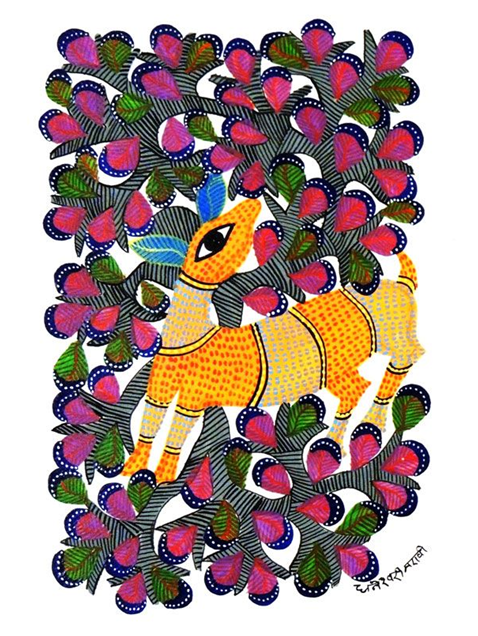 Image: A Gond painting depicting elements of nature through intricate patterns and vivid colours
Image: A Gond painting depicting elements of nature through intricate patterns and vivid colours
There are many Gond festivals with each following a set of rituals and customs.
During Gond festivals the celebrations have entertaining traditional dances; music performances as well as many crafts exhibited which fill the entire environment with colors and cheerfulness. Such ceremonies not only foster community bonds but also help preserve their ethos.
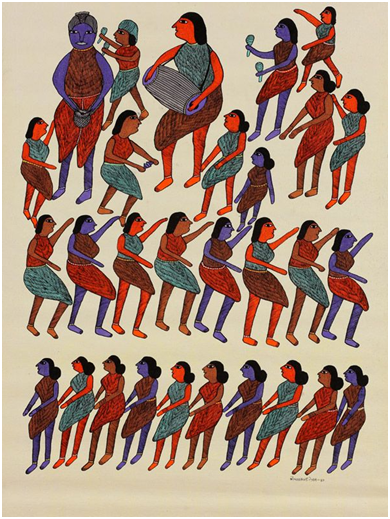
Image: A Gond Painting depicting Gond Community Life through their folk dance
Gond Art: Through the Eye of a Tribesman
Gond art can be enjoyed through paintings that are vivid and versatile. This essential form of art is characterized by its exciting colors, elaborate designs as well as motifs inspired by nature and mythology which are tightly woven in Gond society. Traditionally, Gond art was executed on the walls of their houses for purposes of decoration as well as to invite good luck.
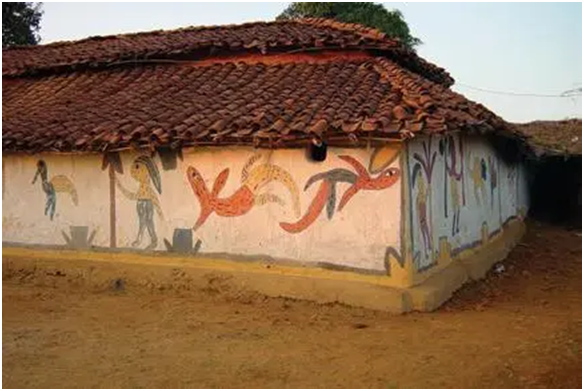
Image: A Gond community home adorned with Gond art
Gond Art Evolution
Over time, there has been a monumental evolution in Gond art. The modern versatility in its forms and styles can be attributed to the shift from murals to canvases, paper or even fabric where these works are now auctioned. Consequently, this change has enabled Gond art to become a part of society by allowing people from different parts of the world to appreciate the beauty and density of these depictions.
Thus began a modern revival of Gond art when many Gond artists started experimenting with new mediums and styles. The late Jangarh Singh Shyam was one such pioneering artist who played a key role in giving tribal arts a place in the contemporary global cultural arena. His innovative techniques and international exhibitions have made Gond art gain worldwide recognition.
Gond art has recently attracted attention from all over the globe among art patrons and collectors. Exhibitions, workshops, and collaborations have helped to globalize Gond art. The simplicity of Gond art yet profoundly deep has made it popular with many as a form of tribal indigenous art.
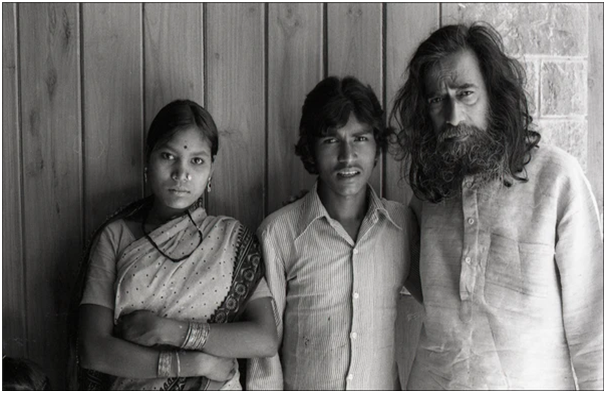
Image: Jangarh Singh Shyam (centre) with wife Nankusiya, and Indian painter J. Swaminathan
How to Support Gond Artists
The rising popularity of Gond art has also led to the obligation of the need for supporting indigenous artists. Many organizations and initiatives are working towards providing platforms for Gond artists to showcase their work, ensuring fair compensation and preserving this rich cultural heritage.
Those who buy genuine Gond art paintings are not only collecting beautiful artworks but also supporting the livelihoods of Gond artists, thus allowing them to continue practicing their traditional art form as an occupation to earn a substantial livelihood.
The Global Appeal of Gond Artists
In recent times there has been increasing interest in Gond art among art lovers and collectors worldwide. International recognition for Gond art paintings has been facilitated by exhibitions, workshops, and partnerships. It is highly sought after because its simplicity is so deep that it touches many hearts; as a result, it represents one of the choicest tribal arts.
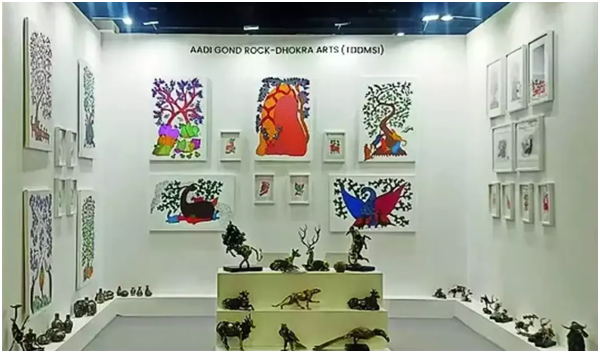
Image: Gond Art being displayed at the 10th edition of the World Art Dubai Expo
Supporting Gond Artists
It is crucial to support the development of Indigenous artists since Gond art is experiencing increased recognition; however, more significant compensation and cultural recognition of Gond artists should be provided for their betterment.
This would further help to preserve this specific cultural heritage. Gond artists have been given opportunities to showcase their work through many organizations with endless efforts.
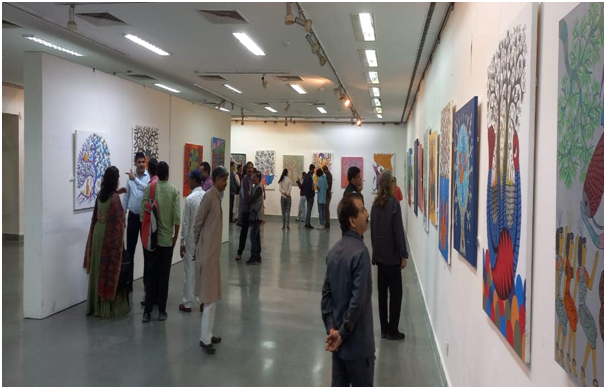
Image: Connoisseurs viewing Gond Art Paintings at an Art Gallery
Ultimately, buying authentic Gond artworks ensures that art lovers get to own some of the finest pieces of art but at the same time Gond painters are paid their due well, to live comfortably wooing their craft.
Conclusion
Gond art paintings are executed uniquely with bright geometrical patterns and expressive narrative motifs have been in great demand. Art enthusiasts all over the world are procuring more Gond art than ever before because of its distinctiveness. That being the case, it is crucial that we as visitors of Gond art on social media, appreciate the necessity of supporting all the artists as well as the Gond community which guarantees that this marvelous tradition is not only conserved for future generations but also developed in all aspects.
Frequently Asked Questions
Q: How important is Gond art as a tradition to portray the folklore of the Gonds?
A: Cultural and religious beliefs of the Gond tribe are inherent in the creation of the Gond style of art – it serves to depict the tribe’s daily activities and its myths, as well as the perceptions related to nature. Music and dance are integral parts of their festivities and rituals.
Q: How has Gond art evolved?
A: Local artists dominated the socio-cultural realm of Gond art that was initially limited to the walls of Gond dwellings. This art form however has over time transitioned from being on walls and made its way into other contemporary mediums such as canvases and papers due to artists like the Late Jangarh Singh Shyam. Thanks to this development, more people are now familiar and there is a broader appreciation spectrum towards Gond art as tribal indigenous art.
Q: What are the common themes depicted in Gond art paintings?
A: Considering figurative themes, subjects selected for Gond art paintings are those that are related to mythology, fables, flora-fauna, etc. which surrounds them. A link or amalgamation of trees/birds/animals and deities is usually seen in the compositions. The concepts depicted relate to the Gond tribe’s closeness with their environment and folklore passed from generation to generation.
Q: How can one support Gond artists to pursue their art regularly?
A: There are several ways one can help support Gond artists; purchasing authentic Gond paintings, participating in workshops as well and visiting the exhibitions. Many organizations aim at popularizing Gond art and also ensure that the artists are not compromised for the payouts for their artworks. It is in these ways one can assist in the cause of Gond art essence, preservation, and continuity.


Related Blog